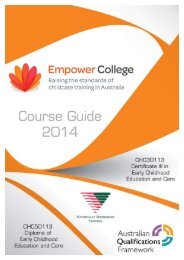Anaphylaxis Management Guidelines
Create successful ePaper yourself
Turn your PDF publications into a flip-book with our unique Google optimized e-Paper software.
In some cases, exposure to an allergen can<br />
lead to an anaphylactic reaction in as little<br />
as five minutes. The following is therefore<br />
recommended:<br />
The adrenaline autoinjector should be stored<br />
in a central, unlocked location, out of reach<br />
for children yet easily accessible to staff.<br />
The adrenaline autoinjector should be<br />
placed away from direct heat or sunlight.<br />
It should not be stored in the refrigerator<br />
or freezer. In hot climates the adrenaline<br />
autoinjector should be stored in an esky or<br />
similar container.<br />
The adrenaline autoinjector should be<br />
checked quarterly to ensure it is not<br />
discoloured or out of date, and does not<br />
contain sediment.<br />
A copy of the child’s ASCIA Action Plan<br />
should be kept with the adrenaline<br />
autoinjector.<br />
The child’s adrenaline autoinjector should<br />
be distinguishable from other childrens’<br />
adrenaline autoinjector and medications.<br />
For example, each child may have a plastic<br />
container clearly labelled with their name,<br />
into which their medications including the<br />
adrenaline autoinjector and ASCIA Action<br />
Plan can be kept.<br />
All staff should know where the adrenaline<br />
autoinjector is stored.<br />
The adrenaline autoinjector should be<br />
signed in and out when taken from its usual<br />
place, for example excursions.<br />
20 <strong>Anaphylaxis</strong> <strong>Management</strong> <strong>Guidelines</strong>





